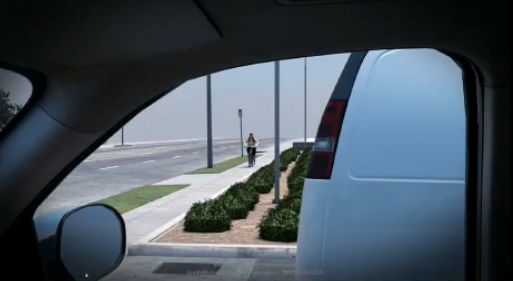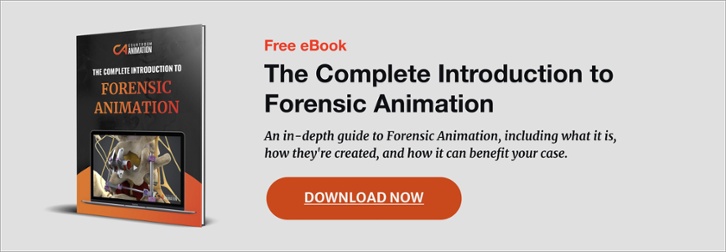
When it comes to personal injury settlements, injury animation is fast becoming the exhibit of choice. To be clear, when we talk about animations, we’re not talking about cartoon animations. We’re talking about highly-accurate forensic animations that are backed by science and experts in their field, and made with measurements backed by data.
In a sense, 3D animations are a way of visualizing data. We can use forensic animations to better visualize surveillance footage, recreate scenes based on witness accounts, recreate surgical operations based on medical records and doctor accounts, and much more.
Using Data to Visualize
High-quality injury animations are made with high-quality data. That can start with a laser scan of the location where the injury took place and collaborating with police officers, forensic experts or scientists, eyewitnesses, and others to create the animated rendition of the event. You can also take the perspective of the opposing party, whether that be the plaintiff or the defense party, and visualize in an animation why their reasoning is incorrect.

This was an unfortunate incident involving a cyclist on a sidewalk that got hit by an SUV. The defense, in this case, argued that the driver wasn’t able to see the cyclist coming, which is why he hit her when he was exiting a parking lot.
By looking at the scene of the event, you would think that the van to the right in the image might be obstructing the driver’s view. But with this animation showing his perspective, we can see that the cyclist is in plain view and that he would have seen her if he looked. Without forensic animation, this would be difficult to explain to a jury.
When asked about the efficiency of this animation, the plaintiff’s attorney on this case, Steve Vartazarian at The Vartazarian Law Firm, said, “This animation sealed the deal, and this was a pretty big verdict.”
The Jury Expects Legal Technology
Due to what we call “the CSI effect,” jurors expect technology to be shown to them during a case. It’s what people see on television shows like CSI: Miami and crime movies. The growing media popularity and jury benefits are a part of why legal technology has been used more and more in court.
“I analyze everything that I can because words aren’t enough,” said Steve Vartazarian. “The jury expects you to use technology. You should, why wouldn’t you if it’s available?”
Steve Vartazarian at The Vartazarian Law Firm
Not only does the jury expect technology during the trial, but the attorney that comes in with a great-looking 3D animation often looks better prepared. Especially when everything in the animation is backed by experts and professionals in their field, an animation helps ensure that you have a leg up on the opposing party.
The Injury Animation Process
Let’s take a look at this animation:
As you can see from this exhibit, it looks like almost a harmless collision. It’s not until we see this realistic depiction of the collision, the moment in time in which spinal damage occurred, and several subsequent spinal surgeries that we understand the true impact. This particular case ended in a $1.6 million verdict.
The attorney on the case, Jon Teller, had this to say, “The quality of the work, and the timeliness of it getting done, all within a reasonable price is why we keep coming back to Courtroom Animation.”
To accurately create these forensic animations, we take a look at the injured person’s medical records and speak with all the physicians involved with the patient. With that data, we can create animation. But that’s not where we stop. We’ll go back to the doctors involved in any medical procedures and ask them to pass judgment. We then take that additional info to implement changes to make it as accurate as possible.
After we have a solid foundation, it’s common to record a doctor demonstrating what they did while they watch the animation.
“Once you do that, you’re already out of the gate. You’re ahead,” said Vartazarian.
What About Injury Animation Admissibility?
If you’ve confirmed your animation with all the experts, taken all the data points, considered the eyewitness accounts, taken a laser scan of the scene, dotted your i’s and crossed your t’s, then there is little reason a judge would not permit you to show your animation to a jury.
To be admissible in court, an animation must meet specific requirements and be based on established facts. If your exhibit doesn’t get admitted, it’s likely because it did not follow court guidelines. While there is no guarantee that an animation will be admissible, trial judges will review them beforehand and express any objections that can be addressed. As long as they’re given enough materials to form an opinion, the animation should be deemed admissible.
One thing judges don’t like to see in animations is unnecessary gore. It could be interpreted that the animation is being leveraged to exaggerate the incident. However, if an animation minimizes the injury by leaving out key details, then it might not be admissible as it won’t be technically accurate. If your adversary and their expert agrees that the animation is not too excessive or minimal, then it has a much better chance of being allowed in court.
By focusing on accurate, professional animations, we’ve achieved a 99% admissibility rate.
Injury Animations Support Evidence
When we talk about admissibility of animations, it’s not classified as evidence. Animations are not created to become new evidence. It’s the judge that gives you permission to show them to the jury. The jury only needs to see them a few times to have a beneficial impact on your case. Usually, that means showing it once in opening, once during the case, and again in closing.
Do you need help winning a personal injury settlement using injury animation? Whatever your needs, Courtroom Animation has the experience and expertise to create an influential animation. At Courtroom Animation, we’ve worked on over 2,000 cases with more than 500 law firms.
Get a no-obligation quote today and one of our case specialists will contact you to discuss the specifics of your case.

Topics: